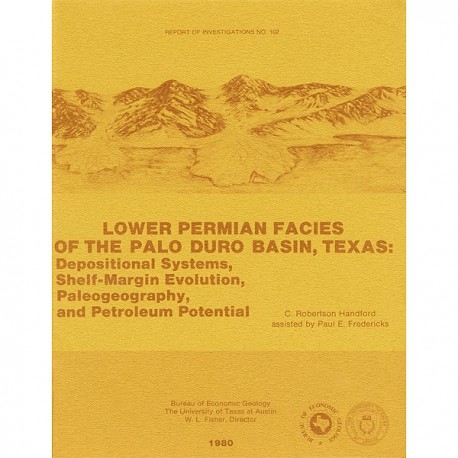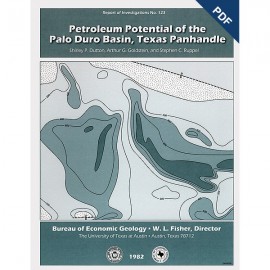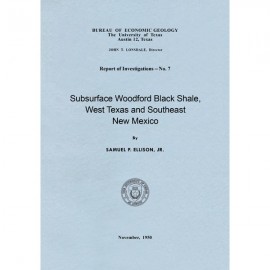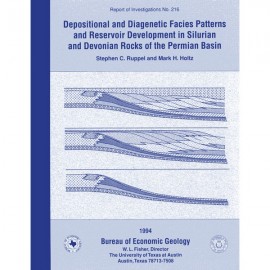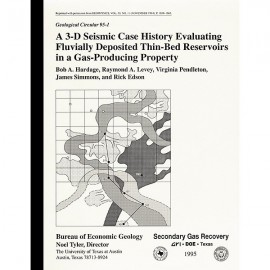Reports of Investigations
-
Books & Reports
- Reports of Investigations
- Guidebooks
- Udden Series
- Geological Circulars
- Down To Earth
- Atlases of Major Oil and Gas Reservoirs
- Texas Memorial Museum Publications
- Environmental Geologic Atlas of the Texas Coastal Zone
- Mineral Resource Circulars
- Other Reports
- Seminars and Workshops
- Handbooks
- Submerged Lands of Texas
- Symposia
- Annual Reports
- Open File Reports
-
Maps & Cross Sections
- Thematic Maps
- Miscellaneous Maps, Charts & Sections
- Geologic Atlas of Texas
- STATEMAP Project Maps
- Geologic Quadrangle Maps
- Cross Sections
- Highway Geology Map
- Energy and Mineral Resource Maps
- Shoreline Change and Other Posters
- Wilcox Group, East Texas, Geological / Hydrological Folios
- Bouguer Gravity Atlas of Texas
- River Basin Regional Studies
- Featured Maps
- Posters
- Teachers & the Public
-
Geological Society Publications
- Gulf Coast Association of Geological Societies
- Alabama Geological Society
- Austin Geological Society
- Corpus Christi Geological Society
- Houston Geological Society
- Lafayette Geological Society
- Mississippi Geological Society
- New Orleans Geological Society
- South Texas Geological Society
- GCS SEPM Publications
- Historic BEG & UT Series
Lower Permian Facies of the Palo Duro Basin, Texas: Depositional Systems, Shelf-Margin Evolution, Paleogeography
RI0102
Lower Permian Facies of the Palo Duro Basin, Texas: Depositional Systems, Shelf-Margin Evolution, Paleogeography, and Petroleum Potential, by C. R. Handford. 31 p., 26 figs., 2 tables, 1980. ISSN: 0082335X: Print Version.
A free, digital version of this publication can be found on: Texas ScholarWorks
RI0102. Lower Permian Facies of the Palo Duro Basin, Texas: Depositional Systems, Shelf-Margin Evolution, Paleogeography, and Petroleum Potential, by C. R. Handford. 31 p., 26 figs., 2 tables, 1980. ISSN: 0082335X: Print.
To purchase this publication as a downloadable PDF, please order RI0102D.
ABSTRACT
Lower Permian (Wolfcampian) strata of the Palo Duro Basin consist of thick, terrigenous clastic and carbonate facies that were deposited in (1) fan-delta, (2) high-constructive delta, (3) carbonate shelf and shelf-margin, and (4) slope and basinal systems. Through Early Permian time, terrigenous detritus was eroded from surrounding highlands and transported by fluvial processes into the Palo Duro Basin. On the Amarillo Uplift and Bravo Dome, exposures of Precambrian basement yielded large quantities of arkosic sand and gravel (granite wash) that were deposited in progradational fan-delta systems. Concomitantly, high-constructive deltas transported subarkosic sand and mud into the southeastern Palo Duro Basin from the Wichita Uplift, or the Ouachita tectonic belt in Texas, or from both areas.
During earliest Wolfcampian time, high-constructive deltas prograded westward beyond the shelf margin into deep, open marine water. As a result, thick (200 ft) delta-front sands were deposited. By middle Wolfcampian time, the supply of terrigenous sediment was reduced and shelf margins had prograded far into the basin. Deltas were restricted to the shallow shelf behind the shelf margin where thin (50 ft) delta-front sands accumulated.
A carbonate bank and shelf-margin complex, probably composed of calcareous algae, foraminifers, and sponges, was present seaward of delta systems and faced southward into the Midland Basin. Thicknesses of stratigraphic sequences indicate that shelf-margin complexes probably stood approximately 200 to 400 ft (60 to 120 m) above the basin floor.
Basinward termination of shelf-margin strata is sharp in many places, giving rise to thick basinal and slope shales and dark-colored micritic limestones. Lenticular, basinward-thickening accumulations of shale occur along shelf margins in slope or submarine fan-head feeder channels that served as major pathways for clastic input to the deep basin. Feeder channels occur near seaward limits of delta lobes, which suggests that most deepwater sediment was derived from delta systems.
Interplay between delta-lobe advances and episodes of carbonate bank development provided a mechanism for shelf-margin progradation. As deltas prograded across shallow-shelf environments into shelf-margin terrain, carbonate productivity was reduced, and large quantities of fine-grained deltaic sediment were carried into the basin by feeder channels. As a result of increased terrigenous sedimentation, thick sediment wedges, or submarine fans, were built across the slope and the basin. Eventually, delta lobes were abandoned, clear-water conditions returned, and carbonate productivity increased. Coalescing carbonate banks accreted basinward over slope wedges and formed a new shelf margin seaward of the previous shelf margin. In contrast to highly progradational shelf margins in eastern Palo Duro Basin, western shelf margins are mainly aggradational. No major delta systems were present to furnish large quantities of sediment needed for development of thick slope wedges. Consequently, western shelf margins were not able to prograde significantly.
Repeated cycles of slope-fan sedimentation followed by carbonate shelf-margin progradation quickly filled the Palo Duro Basin. By the end of Wolfcampian time the basin was transformed from a relatively deep basin into a wide, peritidal shelf environment.
Potential hydrocarbon reservoirs occur in shelf-margin carbonates, delta-front sandstones, and fan-delta arkoses. Zones of porous (greater than 10 percent) dolomite are concentrated near shelf margins and have configurations similar to productive Lower Permian shelf-margin trends in New Mexico. Delta-front sandstones (log-computed porosity of 18 to 25 percent) are similar to producing deltaic sandstones of Morris Buie-Blaco Fields in North-Central Texas. Porous (18 percent) fan-delta sandstones along the south flank of the Amarillo Uplift may form reservoirs similar to that of the Mobeetie Field on the north side of the Amarillo Uplift in Wheeler County, Texas.
Potential hydrocarbon source beds occur in slope and basinal environments. Total organic carbon generally ranges from 1 to 2.3 percent by weight and averages 0.589 percent by weight.
Keywords: depositional systems, Wolfcampian, Palo Duro Basin, hydrocarbons, petroleum potential, Panhandle, Texas
Citation
Handford, C. R., 1980, Lower Permian Facies of the Palo Duro Basin, Texas: Depositional Systems, Shelf-Margin Evolution, Paleogeography, and Petroleum Potential: The University of Texas at Austin, Bureau of Economic Geology, Report of Investigations No. 102, 31 p.
